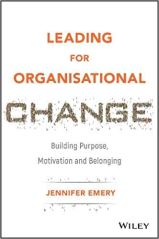
And they all lived happily ever after: Why change leaders need to ditch process in favour of telling a good story
So, your organisation is facing change. You’re in charge. What is the first thing you’re going to turn to, to help everyone make it through?
Chances are, the first thing you thought of was something around writing a plan or sketching out a bit of a process map. We humans love to sense-make. Our brains hate uncertainty, and it makes us feel threatened and scared. If a plan or a process can mitigate that, bring it on. Countless books on ‘the ultimate change process’ also peddle the view that a checklist and a gantt chart might be the best way forward. If you have a step by step plan, everything will work itself out, right? Wrong.
The problem with process
Processes and plans are false friends in times of uncertainty,and, worse, can hurt organisations by limiting them and by failing to unleash the full potential of the individuals within them. They also overlook entirely the fact that there’s real value to be actively created during periods of change.
To unlock all of the potential in your people and – by extension – in your organisation, and to benefit from the value that can be created by change, leaders should worry less about the details of any process and focus instead on great storytelling.
We all love a good story. Staying up too late watching a box set, reading by torchlight under the covers when our parents have switched the light off … we are echoing our ancestors around the campfire,– listening, imagining, falling in love, slaying dragons, scaring ourselves silly, hanging off cliffs.
The story of stories
For a long time, psychologists thought that our proclivity for storytelling may be no more than a fun, but ultimately useless, titillation for the restless machine that is our cognition. But a brilliant new study on hunter-gatherer societies, proposes[i] that telling stories may in fact be an important mechanism by which critical social knowledge is shared.
Stories are about the ‘rules of the game’ and they help to promote cooperation and to encourage groups to bond. For this reason, they are an invaluable tool for organisations during periods of change. When things are volatile or uncertain, people need something to hold them together and help them move forward in a coordinated way. Visions and strategy statements lose their power a little when complexity and ambiguity make it hard to discern the path ahead. But stories are less linear and can function at a different level. They can clarify and galvanise even when the times are uncertain and scary.
Story superpowers
Not any old story will do, though. The best stories – the ones that give you goosebumps, or make you cry, or prompt you to go home and sell everything you have and pack a bag – those are the stories that speak straight to the heart of what it means to be us: who we are, why we’re here, what matters, why we do what we do and how we do it. In other words, stories that speak into our purpose and values and bring them to life.
Those organisations – and their leaders – who are clear about why they are here and doing what they’re doing …. those businesses and leaders who can craft and tell stories that communicate those things well, individually and corporately …. those are the businesses and leaders who are better able to drive long term value by tackling the big challenges and grabbing hold of the big opportunities, that periods of profound change present.
Stories enable leaders to, for example:
- Convey and maintain absolute clarity of purpose
- Sense-make and bring order from chaos
- Reconcile individual purpose with corporate purpose
- Engage at the whole-human emotional level (where change actually happens) instead of just at the rational, cognitive level
- Ignite discretionary effort
- Encourage agile grassroots decision making, and
- Build community and belonging
Are you sitting comfortably?
So, how should leaders who want to embrace storytelling get started? Here are a few ideas:
- Tell the organisation’s story you are sick of hearing it – and then tell it again and again. And make every time sound like the first time.
- Tell your own story, with vulnerability and passion
- Ask other people to tell their stories
- Help people to sense make and link their own stories to the wider organisational purpose
[i] Smith, Schlaepfer, Major, Dyble, Page, Thompson, Salali, Mace, Astete, Chaudhary, Ngales, Vinicuis & Migliano. “Cooperation and the evolution of hunter-gatherer storytelling” Nature Communications volume 8, Article number: 1853 (2017), 5 December 2017
Read more about Jen’s experiences in leading people, culture and change during the UK’s largest legal merger.





